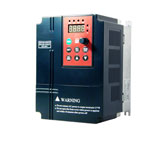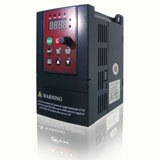Inverter duty motor on variable frequency drive
An inverter duty motor can deal with the higher voltage spikes produced by VFDs also can run at very slow speeds without overheating. The general purpose motor don´t, it can overheat if it is running too slowly, so bearings and insulation will be damaged.
My understanding is that Variable Frequency Drive (VFD) controllers can vary voltage and amps, as they vary frequency, in order to get the required torque and power at lower speeds.
In many industrial applications this issue may be critical because very high start torque can be required, forcing high voltage or current to the motor, but this does not apply on centrifugal pumps.
As the affinity laws show, required power and torque is very low at just half the speed. A centrifugal pump application with VFD will do fine in the 50% to 100% speed range, so in my opinion, standard motors work perfectly well with variable speed driven pumps.
As soft start is included in VFDs, mechanical parts will last longer. I believe there may be some marketing intentions in the "special motor" for variable frequency drive, I don't know why electrical windings should have a shorter life if winding has a good quality. Operating temperature is not an issue, as current is low when the pump runs at low speed, the fan will vent lower, but motor generated heat will also be lower. (Required power is much lower in a pump at lower speed)
I admit not all motors work in the same manner with VFDs, but it has happened to me to find out a pump didn't work stable at low rpm with a 15 khz inverter, and was solved with a 5 khz inverter. So not only the motor should be put in consideration here, but the inverter itself.
Please take note that these VFD considerations are made for pump motor applications, please don't take them out of context.
My understanding is that Variable Frequency Drive (VFD) controllers can vary voltage and amps, as they vary frequency, in order to get the required torque and power at lower speeds.
In many industrial applications this issue may be critical because very high start torque can be required, forcing high voltage or current to the motor, but this does not apply on centrifugal pumps.
As the affinity laws show, required power and torque is very low at just half the speed. A centrifugal pump application with VFD will do fine in the 50% to 100% speed range, so in my opinion, standard motors work perfectly well with variable speed driven pumps.
As soft start is included in VFDs, mechanical parts will last longer. I believe there may be some marketing intentions in the "special motor" for variable frequency drive, I don't know why electrical windings should have a shorter life if winding has a good quality. Operating temperature is not an issue, as current is low when the pump runs at low speed, the fan will vent lower, but motor generated heat will also be lower. (Required power is much lower in a pump at lower speed)
I admit not all motors work in the same manner with VFDs, but it has happened to me to find out a pump didn't work stable at low rpm with a 15 khz inverter, and was solved with a 5 khz inverter. So not only the motor should be put in consideration here, but the inverter itself.
Please take note that these VFD considerations are made for pump motor applications, please don't take them out of context.



